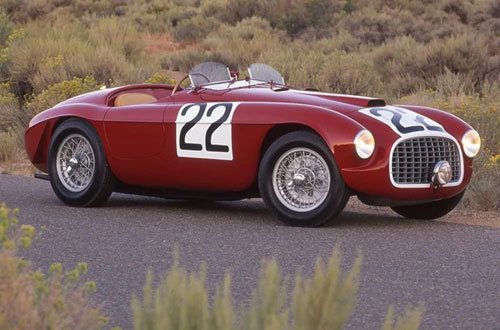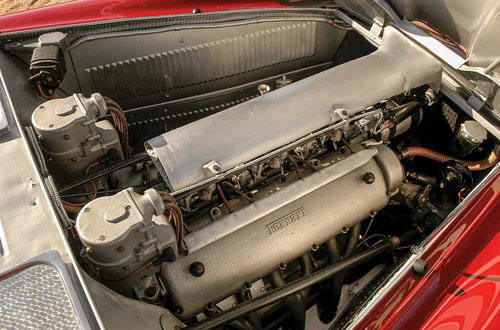|

Summer after summer, I get deeply into the Rush song “Red
Barchetta”. Maybe it’s because I do a lot of cycling in the warm months
and on a favorite route of mine the bucolic country road narrows as it
passes over an old one-lane stone and masonry bridge. And since I’m
often riding my vintage steel-frame, fire engine-red Tourmalet, I
invariably think of those last lines from the second track on Rush’s
1981 album, Moving Pictures:
Neil Peart, Rush’s songwriter and nonpareil drummer-percussionist,
based the song on a short story he read in a November 1973 issue of Road & Track. In Richard S. Foster’s “A Nice Morning Drive”, Buzz
takes his 1967 MG roadster for a spin through the countryside in the
far-off time of March 1982. We learn that mandatory safety and
emissions regulations have rapidly changed automobiles, particularly a
requirement that new cars be able to withstand 50mph collisions. The
result? Hulking 3-ton MSVs—Modern Safety Vehicles—have made
drivers reckless by a perceived lack of danger. One-sided crashes with
conventional cars have quickly winnowed the older vehicles to near
-extinction; some MSV drivers even hunt non-MSVs for sport,
bouncing the old cars off the road.
Near the end of his drive, Buzz notices in his rear-view mirror an MSV
with a suspicious antenna; very quickly he finds himself the quarry of
two MSVs working in tandem via CB radio. Using his knowledge of the
roads and topography, as well as exploiting the disadvantages of the
lumbering MSVs, Buzz eludes his pursuers. The story concludes with a
bleak afterword that Buzz stopped driving his MG when he read in the
papers that the government would soon require cars to sustain 75mph
head-on collisions.
As short stories go, “A Nice Morning Drive” barely transcends
corporate ad copy, grinding its singular ax with as much subtlety as a
sailor in a bordello. Peart transforms a middling exercise in libertarian
bellyaching into a dystopian masterpiece. The future portrayed in
“Red Barchetta” abounds with darkness. With just a few brushstrokes,
Peart sketches a world in which the Motor Law, far from merely
regulating automobile emissions and safety standards, has rendered
farms a thing of the past. It’s a sinister police-state in which
surveillance systems monitor people restricted in their travels to areas
within an ominous boundary:
My uncle has a country place, that no one knows about
He says it used to be a farm, before the Motor Law.
Sundays I elude the ‘Eyes’ and hop the turbine freight
To far outside the Wire where my white-haired uncle waits.
Jump to the ground
As the Turbo slows to cross the borderline.
Run like the wind
As excitement shivers up and down my spine.
Down in his barn
My uncle preserved for me an old machine —
For fifty-odd years
To keep it as new has been his dearest dream.
I strip away the old debris that hides the shining car,
A brilliant red barchetta from a better, vanished time.
Fire up the willing engine responding with a roar!
Tires spitting gravel, I commit my weekly crime . . .
Wind in my hair —
Shifting and drifting —
Mechanical music —
Adrenaline surge —
Well-weathered leather
Hot metal and oil
The scented country air
Sunlight on chrome
The blur of the landscape
Every limb aware
Suddenly ahead of me, across the mountainside
A gleaming alloy air-car shoots toward me two lanes wide.
I spin around with shrieking tires to run the deadly race,
Go screaming through the valley as another joins the chase
Drive like the wind
Straining the limits of machine and man
Laughing out loud
With fear and hope, I’ve got a desperate plan
At the one-lane bridge
I leave the giants stranded
At the riverside
Race back to the farm
To dream with my uncle
At the fireside….
In a deft move at song's end, Peart injects a subtle note of narratorial
ambiguity: perhaps the whole adventure was merely a reverie of the
narrator while sitting fireside with his uncle.
As you listen to “Red Barchetta” you immediately notice how perfectly cinematic it is. To riff off another Rush song, “Red Barchetta” achieves
an ideal balance between the function and the form, its music so
complementary to the story being told. As Neil Peart said in an
interview, “it’s kind of like a little soundtrack for an imaginary movie.”
In my current summertime obsession with the song I checked
YouTube to see if there was in fact a video, but Rush never made an
“official” one (though there are plenty of live performances worth
watching.) What I found instead is a cottage industry of fan-generated
videos using film, photos, and drawings. I’m partial to one with
extended segments of professionally filmed footage of a young man
driving an actual Barchetta along autumnal Pacific Northwest roads.
Now about that Barchetta….
Among the many improvements Peart makes to the story, he upgrades
the car. Buzz, you’ll recall, drives an MG roadster, one of those tiny,
British 2-seaters which have always enjoyed a cult following—and
you’d have to be a cult member to actually like an automobile so
underpowered, not to mention bedeviled by mechanical and electrical
problems. A “Barchetta”—now that sounds like some kind of Italian
sports car, right? You bet!
Aficionados will recognize the reference to the legendary Ferrari 166
MM Barchetta. Some enthusiasts say it’s the most important car
Ferrari ever made. In Italian, “barchetta” means “little boat” (to clarify,
it’s pronounced “bar-ketta,” but Canadian-born Geddy Lee, Rush’s lead
singer, didn’t know it at the time.) Manufactured between 1947 and
1949, this wee roadster won mightily at the Mille Miglia, the Targa
Florio, the 24 Hours of Spa, and at the most celebrated of all 24-hour
races, LeMans. A mere 1,430 pounds though hardly a dinghy with
paddles, the magnificent “little boat” was powered by a V-12 engine
which provided 166cc per cylinder, hence the “166” designation.

* * * * *
For decades, feather-light carbon-fiber frames have been de rigueur
on the professional cycling circuit. You can understand the pros
wanting to shave off weight over a 2,200 mile-long bike race like the
Tour de France or the Giro d’Italia, but the weekend warriors have to
ride them too—if only to show the world they can afford these
exorbitant technological marvels.
When I get “Red Barchetta” playing in my head while I’m racing on my
Tourmalet over country roads surrounding my home in Princeton,
New Jersey, I’m often reminded of a line from Aragorn’s iconic
identity poem in The Lord of the Rings: “The old that is strong does
not wither.” Out on the road I also remember an instructive bon mot
from the greatest cyclist of them all, Eddy Merckx: “Don’t buy
upgrades, ride up grades.” And when I spot one of cycling’s
all-too-common effete elites on a $6,000 bicycle with a $20 set of
lungs . . . ah, that’s when me and my Tourmalet—my two-wheeled red
Barchetta—take savage pleasure in dusting them.
|